Tomato Gravy – Turn tomatoes into a legendary red gravy for a Southern comfort food classic! Juicy tomatoes simmered with smokey bacon drippings and savory chicken broth for jam-packed flavor. Biscuits, meatloaf, and spaghetti are better smothered in a delectable tomato gravy.

The farmer’s market offers an array of colorful veggies, including fresh, juicy tomatoes. And those bright, beautiful red tomatoes brought back memories of my Auntie’s famous tomato gravy recipe.
Tangy, savory tomatoes complement the gravy’s creaminess, taking its flavor factor over the top. And while this is Southern tomato gravy, you can easily adapt it. The African version below is in the recipe variations. 😉

Tomato Gravy vs. Tomato Sauce
First off, gravy is a sauce. But gravy bases enjoy a roux of flour and fat (in this case, bacon drippings). The blonde roux (the lightest roux) provides a deep flavor and thickens the gravy. Also, the liquid base is usually broth (tomatoes add color and taste).
The tomato sauce base, on the other hand, is usually pureed or diced tomatoes simmered until thick enough. So the simplified difference is: tomato gravy uses a roux and broth, and tomato sauce is pure tomatoes.
Recipe Ingredients

- Tomatoes – The star of this dish, tomatoes give the gravy its sweet, tangy flavor and beautiful color!
- Bacon Drippings – The first essential ingredient for the roux delivers smokey goodness! Or you can use butter, lard, or vegetable oil.
- Flour – The second of the two essential roux ingredients thickens the gravy.
- Flavorings – Onion, garlic, and thyme add flavor and balance the tomatoes’ acidity.
- Chicken Stock – Broth adds a wonderful meaty flavor. Beef and vegetable stock also work nicely.
- Cream – Dairy improves almost everything, but you can leave it out.
How to Make Tomato Gravy
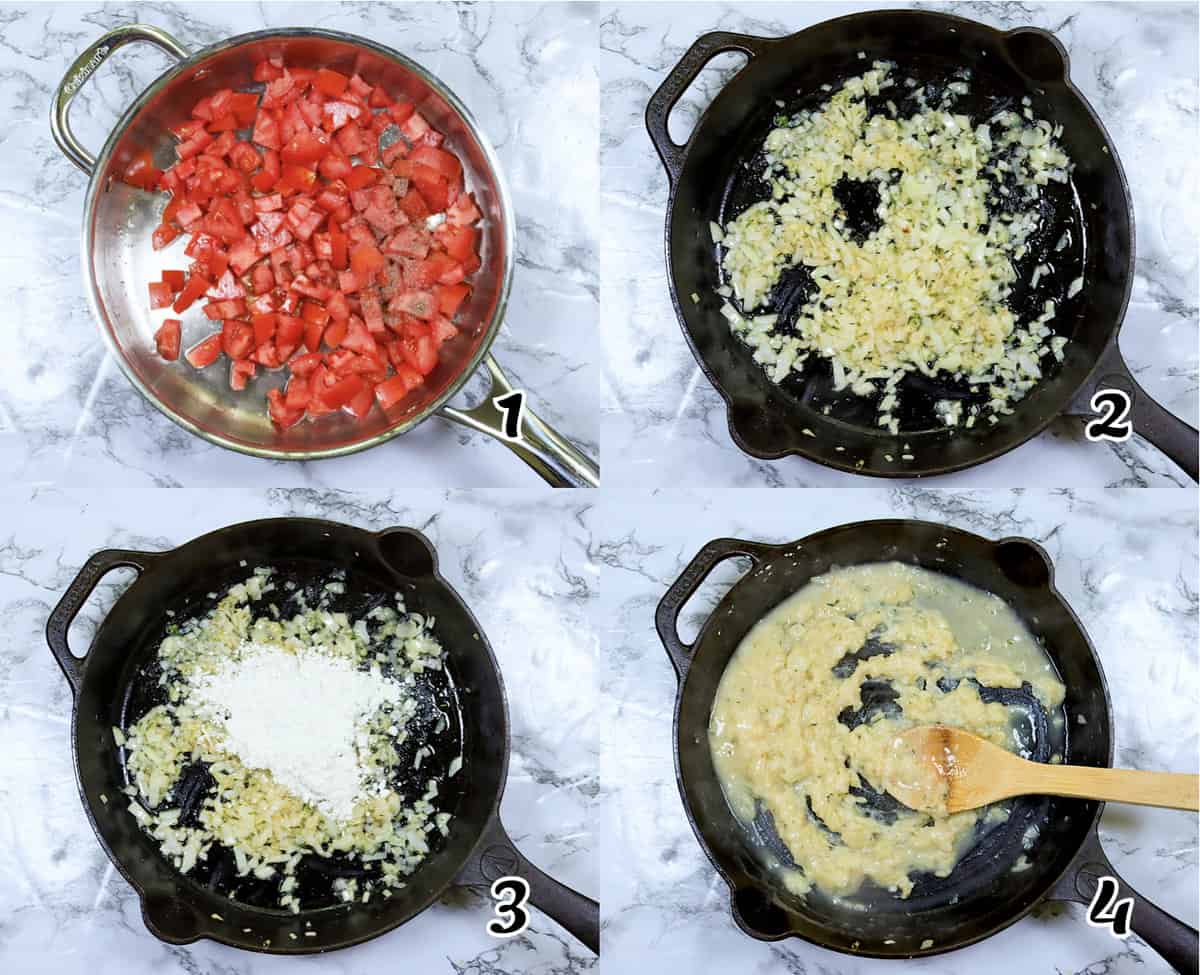
- Saute – Add diced tomatoes to a medium saucepan with a pinch of salt and black pepper. (Photo 1)
- Cook – Place pan over medium-high heat. Stir and simmer for at least 12-15 minutes until tomatoes cook down, forming a thicker paste but with some liquid. Set aside while you make the roux.
- Roux – Place a cast iron skillet over medium-high heat. Heat bacon grease or butter in a cast iron skillet until it melts.
- Sauté – Stir in the onion, garlic, and thyme. Saute for about 5 minutes until the onion is translucent. Add flour, cook stirring for 1-2 minutes until the drippings or butter absorb it all and the mixture is slightly golden. Stir constantly. (Photos 2-3)
- The Base – Pour chicken broth into the skillet, reduce heat to medium-low, and mix until completely incorporated, all lumps are gone, and gravy thickens. (Photo 4)
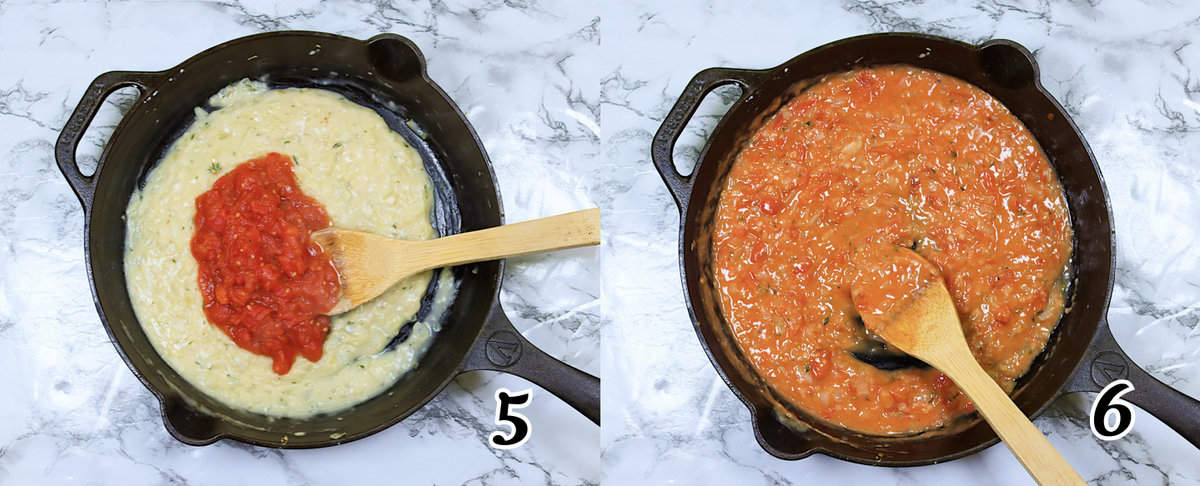
- Simmer – Add stewed tomatoes. Stir well until the gravy is thick enough to spread over biscuits. If the gravy is too thick, add water or broth 2 tablespoons at a time until you achieve the desired consistency. (Photos 5-6)
- Cream – Add heavy cream and mix well.
- Serve – Taste the gravy, and adjust salt and pepper if needed. Serve tomato gravy over hot buttermilk biscuits, rice, or mashed potatoes.
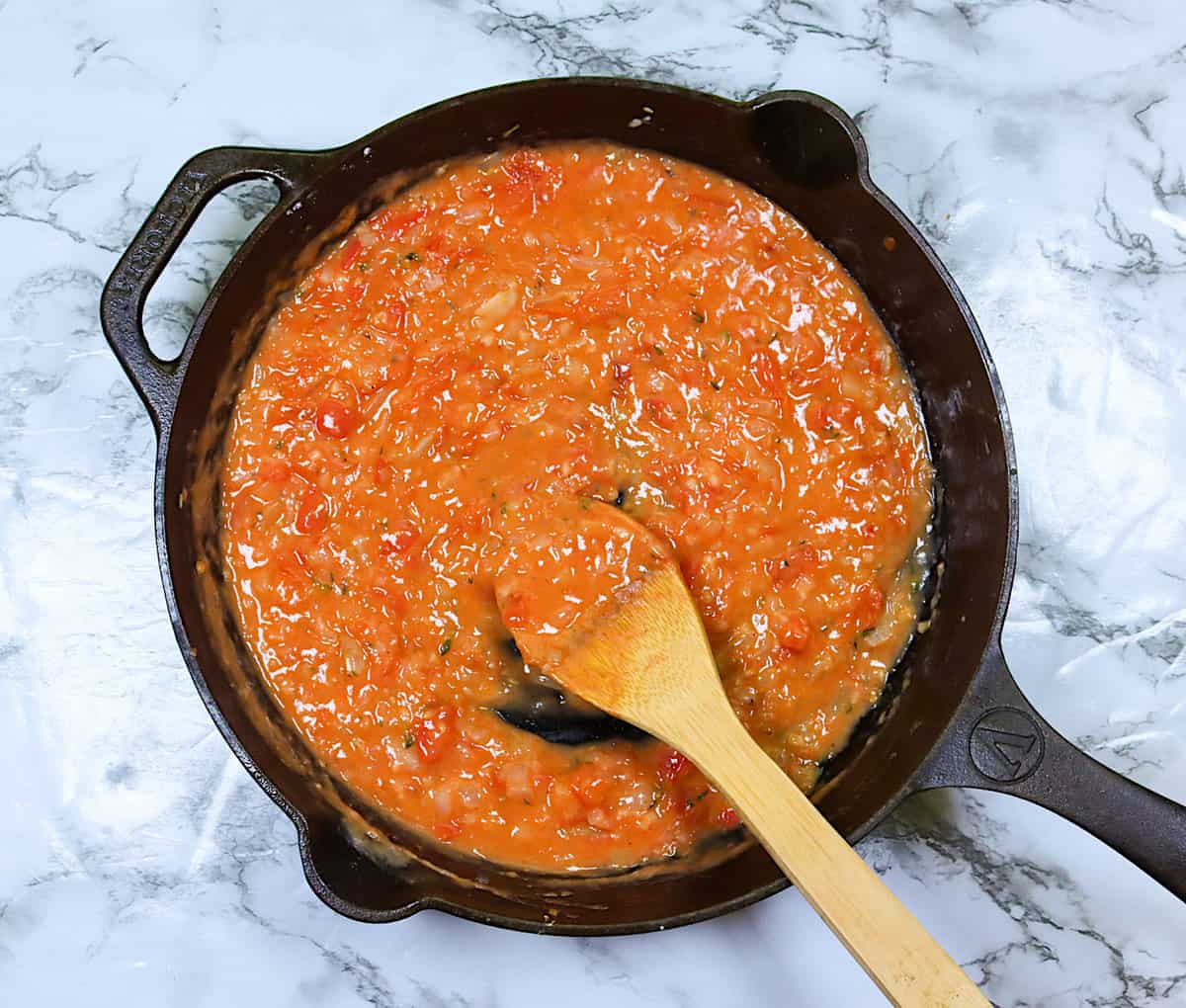
Recipe Variations
- Roast Tomatoes – Roast the fresh tomatoes first. Cut the tomatoes in half, place them on a baking sheet, and drizzle with olive oil. Roast in a 400℉/205℃ oven until caramelized (about 40 minutes).
- Flavor Add-Ins – Authentic tomato gravy doesn’t have thyme, garlic, or cream, but they add flavor. Diced celery, diced bell pepper, and red pepper flakes or a pinch of cayenne works too.
- African Tomato Gravy – Traditional tomato gravy is similar in Africa, and every grandmother has her own recipe, from simple to elaborate. I saute onion in lard or butter, then add 2 cups of chopped tomatoes (canned or fresh). Simmer it, then add thyme, diced bell pepper, a pinch of sugar, and a spoonful of peri-peri sauce. Simmer until it reaches the desired thickness.
Tips and Tricks
- Cook the flour for at least a minute before adding chicken broth to eliminate the raw flour taste.
- Remember that bacon grease is salty, so taste your gravy before adding more salt.
- If you prefer tomatoes without the skins, you can blanch your tomatoes, and the skins will slide off. Put them in a pot of boiling water for about a minute. Then put them in ice water to chill them. The skins should come off easily with your fingers.
Make-Ahead Instructions
Tomato gravy is easy to make, but wait to add the cream. Freeze (6 months) or refrigerate (5 days) in an appropriate airtight container. Then thaw it overnight in the fridge and heat in a saucepan on low. Add the cream after it starts to simmer, adjust the seasonings, and serve.
Serving and Storage Instructions
This gravy is best hot, and it’s fantastically versatile for breakfast, brunch, or dinner. Refrigerate leftover gravy in an airtight container for 5-7 days. Or you can freeze it in plastic freezer bags for 3-6 months.
If the gravy is frozen, defrost it overnight in the refrigerator before reheating. Then reheat in a saucepan over medium-low until hot and bubbly. Add a splash of chicken broth or water if it’s too thick.
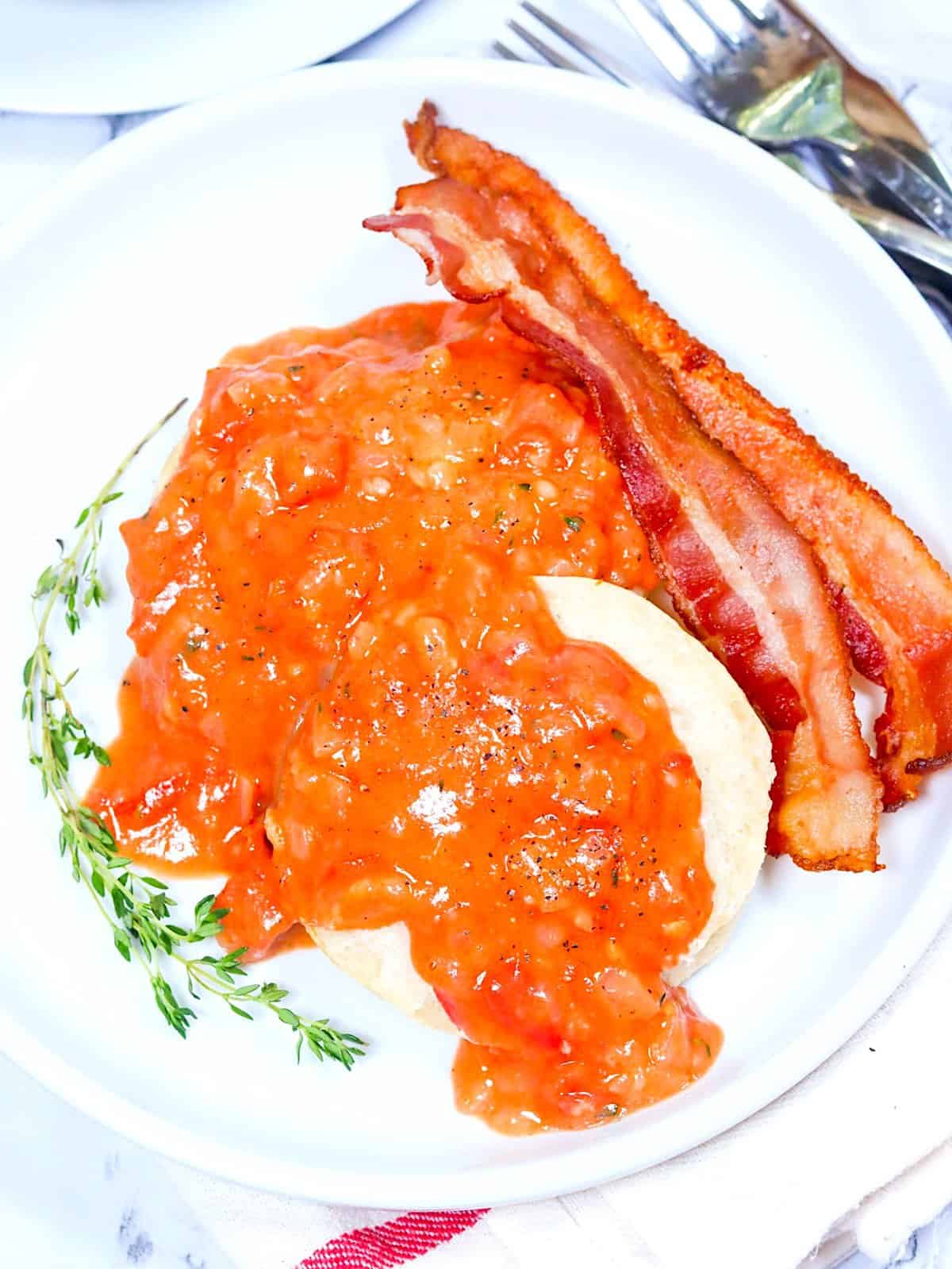
FAQs
Sure! A 15-ounce can of diced tomatoes (fire-roasted tomatoes are good, too) works fine. If you prefer a deeper flavor, add a few tablespoons of tomato paste with the tomatoes.
Of course! Replace the bacon grease with refined coconut or vegetable oil and use vegetable broth instead of chicken broth. And a dash of smoked paprika will replace the smokey bacon flavor.
No worries! Simmer it a little longer to thicken the sauce. Or speed it up by stirring in a slurry with a couple of tablespoons of cool water mixed with a tablespoon of flour or cornstarch. Simmer until thickened.
What to Serve With Tomato Gravy
Traditional Southern buttermilk biscuits and creamy grits casserole deliver a tasty Southern breakfast. Or serve it for dinner drizzled over bacon-wrapped meatloaf, grilled pork belly, or cheesy polenta. Delish!
More First-Rate Sauce Recipes to Try
Conclusion
This hearty and satisfying tomato gravy automatically turns any dish into comfort food! What do you serve with tomato gravy? Let me know in the comments below! 😊
Watch How to Make It
Tomato Gravy
Ingredients
- 2-3 large tomatoes, chopped (bright red and ripe is best)
- ¼ cup bacon drippings (or unsalted butter)
- 1 small onion, diced
- 1 teaspoon minced garlic
- 1 teaspoon minced thyme
- 2 tablespoons all-purpose flour
- 1 cup low-sodium chicken stock
- ¼ cup heavy cream
- salt to taste
- black pepper, freshly ground (to taste)
- 1 tablespoon parsley, finely chopped for garnish (or basil)
Instructions
- Add diced tomatoes to a medium saucepan with a pinch of salt and black pepper.
- Place pan over medium-high heat. Stir and simmer for at least 12-15 minutes until tomatoes cook down, forming a thicker paste but with some liquid. Set aside while you make the roux.
- Place a cast iron skillet over medium-high heat. Melt the bacon grease or butter in a cast iron skillet.
- Stir in the onion, garlic, and thyme. Saute for about 5 minutes until the onion is translucent. Add flour, cook stirring for 1-2 minutes until the drippings or butter absorb it all and the mixture is slightly golden. Stir constantly.
- Pour chicken broth into the skillet, reduce heat to medium-low, and mix until completely incorporated, all lumps are gone, and gravy begins to thicken.
- Add stewed tomatoes. Stir well until the gravy is thick enough to spread over biscuits. If the gravy is too thick, add water or broth two tablespoons at a time until you achieve the desired consistency.
- Add heavy cream and mix well.
- Taste the gravy, and adjust salt and pepper to taste if needed. Serve tomato gravy over hot buttermilk biscuits, rice, or mashed potatoes.
Tips & Notes:
- Cook the flour for at least a minute before adding chicken broth to eliminate the raw flour taste.
- Remember that bacon grease is salty, so taste your gravy before adding more salt.
- If you prefer tomatoes without the skins, you can blanch your tomatoes, and the skins will slide off. Put them in a pot of boiling water for about a minute. Then, put them in ice water to chill them. The skins should come off easily with your fingers.
- Please remember that the nutritional information is a rough estimate and can vary significantly based on the products used in the recipe.
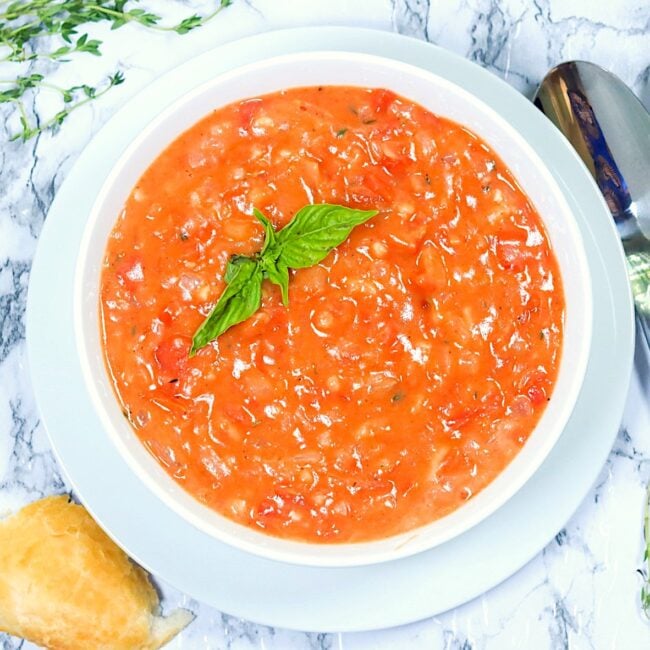
Leave a Review